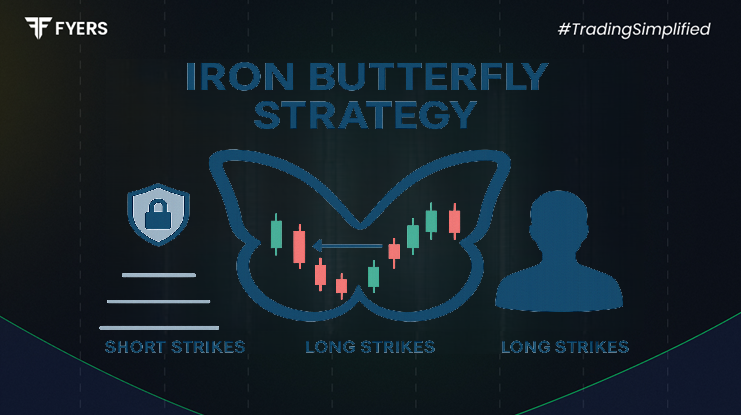

 19 Sep, 2025
19 Sep, 2025
 3 mins read
3 mins read

Options trading involves strategies that balance risk and reward by combining multiple positions. One such popular approach is the Iron Butterfly. This strategy is widely used by traders who expect low volatility and want to earn from time decay while keeping risk defined.
In this article, we will explore what is Iron Butterfly strategy, how it works, its variations, payoff, advantages, risks, and practical examples.
The Iron Butterfly strategy is an advanced options trading setup that combines both a bull spread and a bear spread using call and put options. It is designed to profit when the underlying asset trades near a specific price at expiry.
In simple terms, it involves:
Selling an at-the-money (ATM) call and put (short straddle).
Buying an out-of-the-money (OTM) call and put to limit risk.
This creates a range-bound payoff structure where the maximum profit occurs if the underlying closes exactly at the strike price of the short options.
The Iron Butterfly option strategy is built using four legs:
Sell one ATM Call option
Sell one ATM Put option
Buy one OTM Call option (higher strike)
Buy one OTM Put option (lower strike)
This results in a net credit strategy, meaning the trader receives a premium upfront.
Maximum Profit: Achieved if the asset closes at the middle strike price.
Maximum Loss: Limited to the difference between strikes minus the premium received.
Breakeven Points: Middle strike ± net premium received.
The long Iron Butterfly strategy is the classic version where a trader sells the ATM call and put while buying OTM options for protection.
Ideal Market View: Neutral or low volatility.
Objective: Capture maximum profit if the price stays near the middle strike.
Best For: Traders expecting limited movement in the underlying.
The short Iron Butterfly option strategy is the opposite. Here, the trader buys the ATM straddle (ATM call + put) and sells the OTM options.
Ideal Market View: Expectation of high volatility and large movement in price.
Objective: Profit from big moves in either direction.
Risk Profile: Higher premium outflow but potentially unlimited profit if price breaks out significantly.
The payoff diagram of the Iron Butterfly resembles a tent shape:
Maximum profit occurs at the middle strike price.
Losses increase as the price moves far from the middle strike but are capped due to protective long options.
Breakeven points define the profitable range.
For example, assume:
Nifty is at 20,000.
Sell 20,000 Call and Put.
Buy 20,200 Call and 19,800 Put.
If Nifty closes at 20,000, the trader earns the maximum profit (net premium). If it moves sharply away, losses are capped at the difference between strikes minus premium.
Defined Risk and Reward: Losses are limited due to protective options.
Profits from Time Decay: Works best in low-volatility markets.
Lower Margin Requirement: Compared to selling a naked straddle.
Flexibility: Can be adjusted based on market outlook.
Despite its benefits, the Iron Butterfly strategy has drawbacks:
Limited Profit Potential: Maximum gains are capped.
Requires Precise Forecasting: Works only if the price stays near the strike.
Vulnerable to Volatility Spikes: Sudden news or events can lead to losses.
Complex for Beginners: Four legs make it harder to manage.
Traders typically use the Iron Butterfly option strategy when:
They expect low volatility in the market.
Earnings announcements or events are unlikely to trigger sharp moves.
They want a range-bound income strategy with controlled risk.
They are experienced in managing multi-leg option strategies.
The Iron Butterfly is a well-defined options strategy that helps traders earn in sideways markets with limited risk. By combining a short straddle with protective options, it offers a balance between risk and reward.
However, since profits are capped and the strategy requires precise timing, it is best suited for experienced traders who can analyse volatility and manage option spreads effectively.
Used wisely, the Iron Butterfly strategy can be a valuable addition to an options trader’s toolkit.
It is an options strategy where a trader sells an at-the-money call and put while buying out-of-the-money options for protection, aiming to profit if the price stays near the strike price.
The long Iron Butterfly profits in low-volatility conditions, while the short Iron Butterfly benefits from high volatility and large price swings.
Both are range-bound strategies. The Iron Condor has a wider profit range but lower maximum profit, whereas the Iron Butterfly has higher potential profit but narrower range.
The maximum profit equals the net premium received when the underlying closes at the middle strike price.
Calculate your Net P&L after deducting all the charges like Tax, Brokerage, etc.
Find your required margin.
Calculate the average price you paid for a stock and determine your total cost.
Estimate your investment growth. Calculate potential returns on one-time investments.
Forecast your investment returns. Understand potential growth with regular contributions.